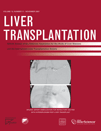Reply: To MELD or not to MELD: Early assessment of prognosis in fulminant hepatic failure
We thank Dr. Huo and colleagues1 for their interest and comments regarding our study of prognostic scores in patients with fulminant hepatic failure (FHF).2 Overall, the two major points raised by Huo et al. are the multifactorial causes of FHF in our series and the limited value of assessing prognosis on admission. FHF should be considered a syndrome rather than a disease because identical clinical, laboratory, and histological abnormalities may be present in conditions of diverse etiology, pathogenesis, and therapy. However, with the exception of acetaminophen toxicity, FHF is associated with mortality rates of 70%-100% if orthotopic liver transplantation (OLT) is not performed. For this reason, in most reported studies of FHF, prognostic variables have been analyzed separately in acetaminophen and nonacetaminophen etiologies.3, 4 In fact, the King's College criteria include a different set of parameters to assess prognosis in these two groups of patients.3 We believe that our series is representative of the whole etiologic spectrum of FHF, aside from paracetamol toxicity, as we clearly stated in the discussion. Although hepatitis A has been regarded as a benign etiology of FHF, this appears not to be true in our geography. We recently showed that prognosis of fulminant hepatitis A (n = 39) did not significantly differ when compared with other etiologies of FHF (n = 91) as assessed by the Model for End-Stage Liver Disease (MELD), the King's College and Clichy criteria. In addition, the survival rate with medical therapy, and the need for OLT.5 Huo et al. suggested that prognostic markers may not be applicable to different etiologies of FHF. However, a recent study from our unit showed that MELD was equally superior to the King's College and Clichy criteria in patients with viral, indeterminate, or other etiologies of FHF.6
The second issue raised by Huo et al.1 is timing of prognosis assessment. It is well known that progression of hepatic encephalopathy is largely unpredictable, as are the onset and severity of extrahepatic complications leading to multiorgan failure. Therefore, assessment of prognosis shortly after hospitalization is crucial to decide the need for pre-OLT evaluation and listing, especially in areas where organ availability is limited. It is important to emphasize that no laboratory test or prognostic criteria will ever replace adequate clinical judgment to decide the need for OLT. The decision to transplant or not in the real clinical scenario, as proposed by Huo et al., is evaluated at frequent intervals and especially when an organ donor becomes available. As described in the methods, indication for OLT in our study was based on severity and progression of encephalopathy and/or coagulopathy in addition to prognostic scores. Huo et al. suggested that need for OLT should be based on a day-to-day evaluation of dynamic parameters. Which parameters? First, no study has yet proven that serial evaluation of clinical or laboratory variables is useful in deciding the optimal timing for OLT. Second, the prognostic value of coagulation parameters such as the prothrombin time and factor V is lost in patients who receive transfusions of plasma before invasive procedures such as placement of intracranial pressure catheters. Third, it has been shown that the diagnostic accuracy of the King's College criteria analyzed at 48 hours or using peak values is less than that obtained on admission.4, 7 Lastly, the median time interval from hospitalization to OLT in our study was 2 days in hyperacute variants of FHF (n = 36) and 3 days in acute (n = 59) and subacute (n = 26) variants of FHF. Therefore, in the majority of patients, the length of follow-up was too short to assess a day-to-day evolution as proposed by Huo et al.
In conclusion, we believe that reported data should be challenged with new data rather than with conceptual statements. We acknowledge the limitations of our patient population, and we hope that other groups will evaluate the prognostic efficacy of MELD in larger series of patients with FHF in order to confirm or reject our findings.
REFERENCES
Silvina Yantorno M.D.*, Federico Villamil M.D. [email protected]*, * Liver Unit, Fundación Favaloro, Buenos Aires, Argentina.




